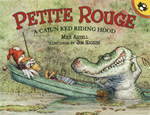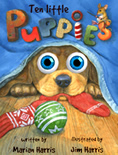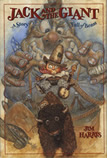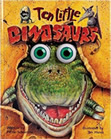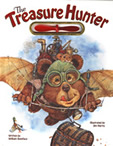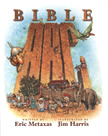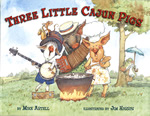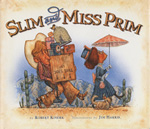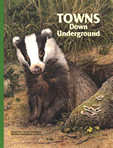Jim Harris Talks About Illustrating…

The Three Little Dinosaurs
“Once upon a time, in a thick steamy jungle, there lived three little dinosaurs.”
(Three little brachiosaurs, to be exact.)
And as happens so often in these stories, the poor little three-some has just been ejected from their home by their darling mother and sent out to find new homes of their own.
(Seems like I’ve heard this somewhere before.)

The first little brachiosaur isn’t into heavy construction work. He would rather play video games. So he piles up some dried grass, and presto… a house!
Unfortunately this is the type of house that attracts the attention of the neighborhood bully. In this case, a T-Rex with a brain the size of a peanut.

At first the little dino harbors a hope that the thump thump thump on his front doorstep might be the pizza delivery man… but no. It’s the T-Rex. And that’s bad.
Pretty soon, the first little brachiosaur is out on the street again, with nothing to his name but his TV. (And maybe his video game.)
Meanwhile, the second little dino has been negotiating with a Stegosaur for some mud bricks.

Steg’s are pretty easy… and soon the second little dino has a load of yellow bricks… and a page later… a very cool house.

Only one problem. Seems like the Stegosaur said something about waiting to use the bricks until after they were dried in the sun… but that seems like such an insignificant detail. Too much for the second little dino to bother with, anyway. He’s busy pumping iron and reading muscle mags.

You know where this story is going… don’t you.
Well, you probably do, except for one little detail. I’m not going to give it away except to say that brachiosaurs are lizards and there is one fact about lizards you might have forgotten.
The T-Rex forgot it and it gave him a big surprise – just when he thought he was going to get three piggy-burgers for lunch.

Oh, I forgot to tell you. The bully T-rex keeps calling the little brachiosaurs “piggies.” It makes them so mad they can’t see straight.
But like I said, the piggies (I mean, the little DINOS) get the best of the T-rex in the end, and he never, ever, calls them “piggies” again.

Well, I actually also have something to say about how I painted the illustrations for this book.
Painting with Oil and Acrylic Together
I painted them with oil and acrylic paints on paper. And that is a little unusual.
Usually we paint with oil on canvas, not paper. And not too many people mix oil and acrylic paints.
Oil paint is my favorite medium. It stays wet a long time, so you can take your time blending your strokes. Also, it doesn’t destroy your paint brushes. And it gives that warm, friendly oil-paint look to the finished painting.
But oil paints have some problems, too. Especially for illustrators on tight deadlines. Like I said, oils take a long time to dry. Which isn’t cool if you’re supposed to be Fed-Ex-ing your illustrations off the next morning! Different oil colors dry at different speeds—a few might dry in a day, but others take a week to be fully dry. (I once mixed the wrong solvent with some red oil paint and it stayed wet for about four years!)
So, sometimes I use acrylics instead. They’re pretty nice paints, too. On the good side, they have vibrant colors, and boy, do they dry quick! In fact, you have to be careful not to squeeze huge dollops of acrylic paint onto your palette if you’re not going to use it right away… because if you walk away for too long… when you come back, all that expensive acrylic paint is dried up like a hunk of plastic and nothing you do to it will make it come back to life. But … it’s helpful to have paint that dries that fast if you’re painting something you have to mail off in a jiffy.
On the down side… acrylic paint is indeed just a special kind of colored plastic, and if you’re not careful, your whole painting will look, well, like plastic. It takes a lot of attention to brush strokes and color choices to get an acrylic painting to look soft and warm.
On The Three Little Dinosaurs I used a special kind of oil paint that you mix with water (instead of stinky turpentine—which gives me a terrible headache) and when you’re done painting… you can wash up your brushes with water instead of turpentine, too.
Washing up. That reminds me of another problem with acrylic. It’s like ink… it eats brushes. Ink has lacquer in it, which gets up in the paintbrush follicles—where the hairs are attached to the paintbrush handle—and dries in there and then the lacquer is so sharp-edged that it actually cuts through the hairs and they just fall off. Very discouraging.
Acrylic does something similar. It dries up in the follicles and there’s no hope of ever washing it out… it just sits in there and pushes against the hairs and makes them poke out at all sorts of funny angles… and your whole brush shape is ruined forever. Makes you want to cry…
You can minimize this by remembering to wash out your paintbrushes as soon as you’re done painting with acrylics… but you can never make this problem go completely away.
But back to The Three Little Dinosaurs… I painted most of each illustration with my special water-based oil paint. And then went back in and added the details in acrylic.

If you decide to try this technique, just remember one thing. You can always paint oils on top of acrylics. That works pretty well every time. But you can’t paint acrylic on top of oils, unless you use water-based oils, like I do. Trust me on that. Don’t even think about breaking this trusty little rule. Unless you want to watch your whole painting slide off onto the table one day.
Well… I’m supposed to be sketching out a new book today, so I’d better get back to work.
Happy painting!
Images and Text © 2009 Jim Harris. All Rights Reserved

